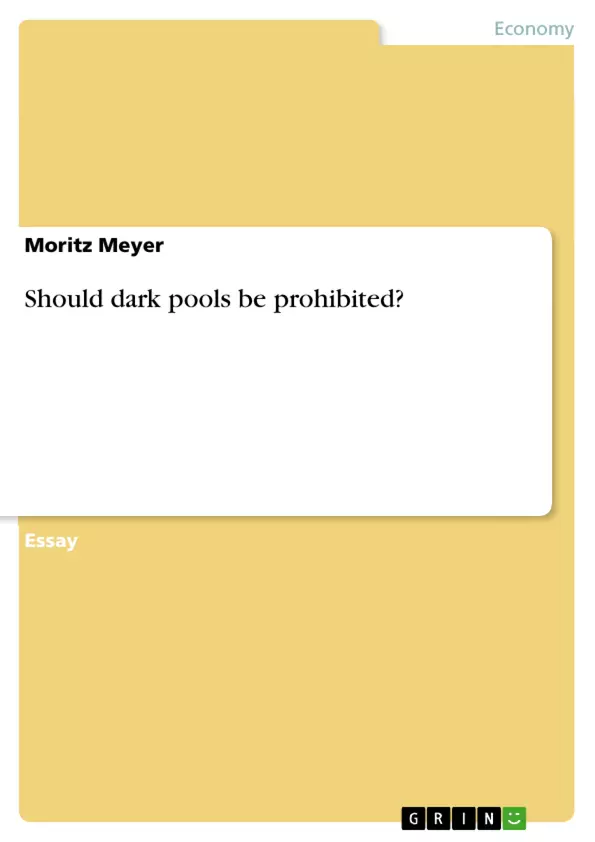Should dark pools be prohibited? Discuss this statement by exclusively presenting arguments that this is not the case.
A dark pool is defined by Banks (2010) as an alternative trading system for the anonymous trade of standardised financial products. Pan (2017) specifies it as mainly an equity trading venue. The trades in a dark pool are, according to Ye (2016), concluded outside of any display order. This differs from lit markets, such as traditional stock exchanges, as the trade, according to Comerton-Forde and Putniņš (2015), is only made public after it has been executed. Dark pools are a highly unregulated market sector and not subjected to the rules and regulations of the European stock exchanges, as Baxter (2017) highlights. Petrescu and Wedow (2017) therefore assumed that the key feature of dark pools is less transparency compared to lit markets, i.e. market participants do not have an overview of the supply and demand of the products. The traders purchase and sell on dark pools without showing their identities or exposing transactions to the public market; therefore, the available liquidity in the dark pool is anonymous, as pointed out by Kratz and Schöneborn (2014). The price of a successful order is calculated, as claimed by Banks (2014), as the midpoint of the bid and offer. Zhu (2014) states that the execution of an order in a dark pool is not guaranteed, unlike the traditional stock exchange.
Inhaltsverzeichnis (Table of Contents)
- A dark pool is defined by Banks (2010) as an alternative trading system for the anonymous trade of standardised financial products.
- Dark pools should not be prohibited due to the fact that much higher levels of market quality can be reached with dark pool trading.
- First, dark trading is advantageous for the financial system because of less transparency against the traditional exchanges, as argued by Garvey, Huang and Wu (2016).
- The second advantage of dark pools, as pointed out by Aubrey (2009), is the lower trading fees compared to traditional exchange charges, also known as direct costs.
Zielsetzung und Themenschwerpunkte (Objectives and Key Themes)
The objective of this paper is to argue against the prohibition of dark pools by highlighting their positive contributions to market quality. The author argues that dark pools enhance market quality through increased anonymity and reduced trading costs.
- Market quality and dark pool trading
- Transparency and anonymity in financial markets
- Trading costs and market efficiency
- Competition in financial markets
- Regulation of dark pools
Zusammenfassung der Kapitel (Chapter Summaries)
The paper begins by defining dark pools and outlining their key characteristics, emphasizing their lack of transparency compared to traditional stock exchanges. It then presents two main arguments in favour of dark pools: their contribution to market quality through increased anonymity and their lower trading costs.
The first argument focuses on the anonymity provided by dark pools, which allows large institutional investors to execute large trades without significantly impacting the market price. The second argument emphasizes the cost savings associated with dark pool trading due to lower trading fees and the possibility for brokers to preserve more of the spread, leading to benefits for both brokers and clients.
Schlüsselwörter (Keywords)
Dark pools, market quality, anonymity, trading costs, financial system, transparency, competition, regulation, institutional investors, price discovery.
- Quote paper
- Moritz Meyer (Author), 2017, Should dark pools be prohibited?, Munich, GRIN Verlag, https://www.grin.com/document/426430



